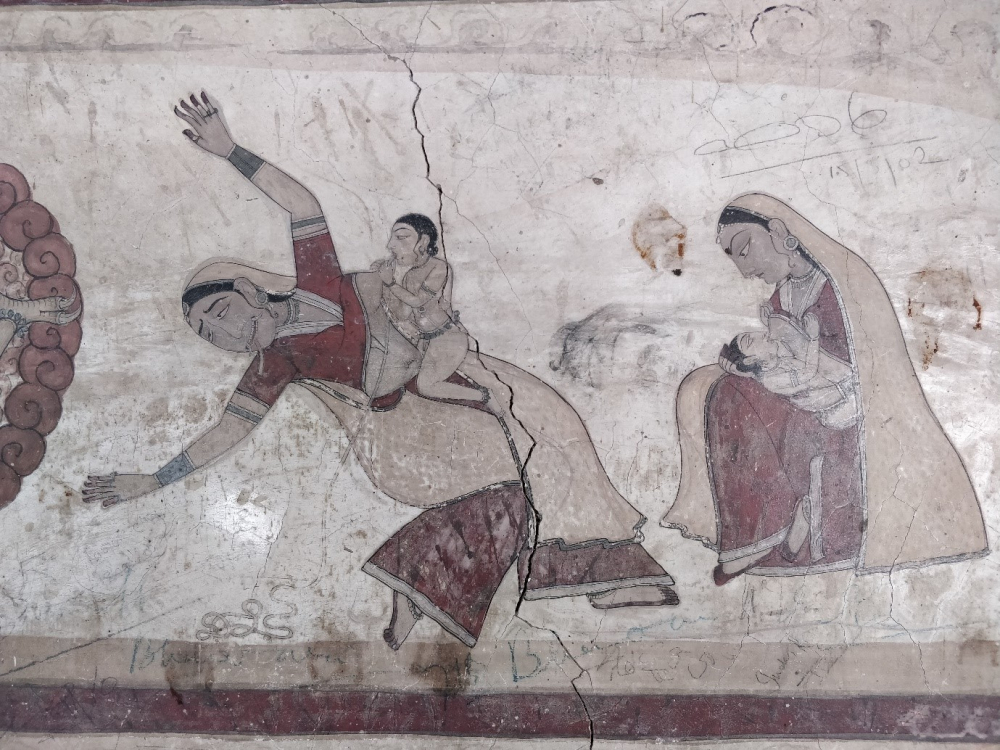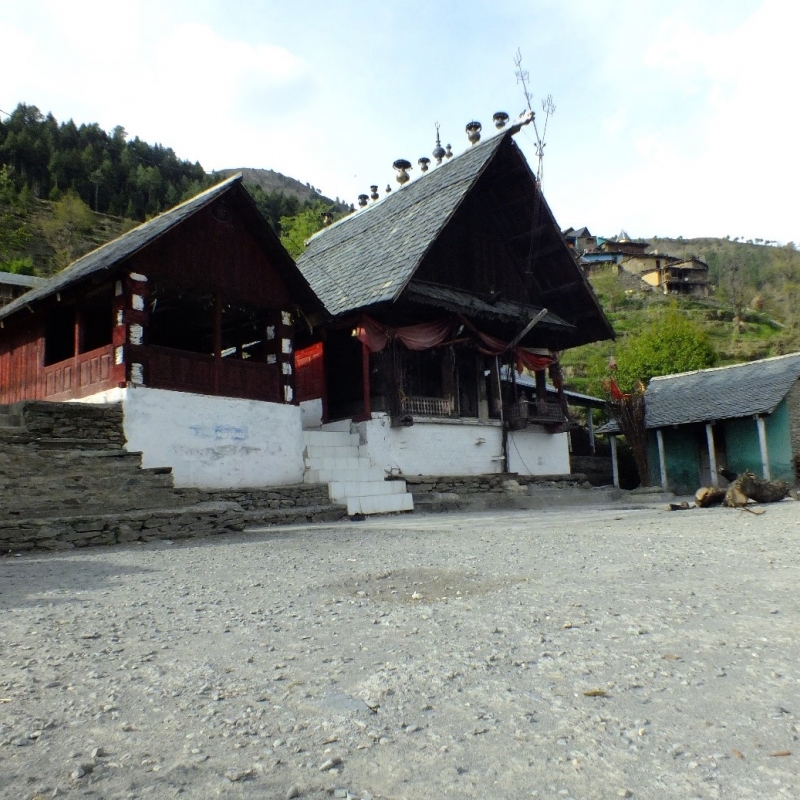The Devi Kothi temple, in Chamba district of Himachal Pradesh, was constructed by Raja Umed Singh in 1754 CE. According to Chamba’s folk narrative, the king commissioned the construction of the temple, dedicated to Goddess Chamunda, on the fulfilment of a wish.
Raja Umed Singh was inclined towards Devi (Hindu divine mother) worship as is evident from other goddess temples scattered throughout the region. He was a devout believer in the Shakti cult (which worships Devi and her avatars) and is known to have built another Chamunda temple in Chamba, the capital of the province, that bears striking resemblance to the temple of Devi Kothi.
The Churah (literally, four paths) valley, where the Devi temple stands, had strategic importance for the erstwhile state of Chamba, as it served as the northwestern frontier of the kingdom. It may be said here that by establishing a royal temple at such a crucial frontier, the king of Chamba might have intended to strengthen his stronghold over the Churah belt. The temple walls decorated with murals bear strong stylistic similarities with the miniature painting tradition in Chamba during the mid-eighteenth century.
Dedicated to Goddess Chamunda, most of the painted panels in the temple exhibit her triumph over demons. Chamunda, the fearsome form of Durga, finds mention in the Hindu religious text ‘Devi Mahatmya’ (part of Markandeya Purana) as the warrior goddess who slew the demons Chanda and Munda. The rulers of Chamba and Kangra were avid devotees of Chamunda, who served as their inspiration in the battlefield. Episodes from ‘Devi Mahatmya’, illustrated on the temple walls, either show the goddess slaying demons or her being adorned by other gods. Raja Umed Singh had commissioned artists to undertake the mural works to decorate the walls of the temple as well as provide visitors with a glance of the Devi’s extraordinary powers and combative strengths.
Otherwise dominated by impressions of the Shakti cult, the eastern wall of the temple is the only part dedicated to the legend of Krishna, influenced by the Vaishnavite Bhakti movement prevalent all over north India during the time. (Fig. 1)

A Brief History of Chamba Miniature Painting
The Chamba miniature painting tradition, a sub-school of the larger Pahari (hill) painting, which inspired the murals of the Devi Kothi temple, had its beginnings in the mid-seventeenth century. Along with Chamba, Nurpur and Basohli were the earliest centres that practised the tradition of Pahari painting. The three former principalities are in close geographical proximity to each other and have a long history of diplomatic alliances and matrimonial ties. At times, the three hill states were also in constant warfare and competed among themselves for cultural ascendancy. While the early paintings from these states had almost identical stylistic elements, by the eighteenth century, the various schools of art started to exhibit distinctive traits and began establishing their own identities. Artists who migrated from one court to another were also vital in the development of various styles in a single atelier. This phenomenon paved the way for numerous sub-schools working in close proximity for the same patron. The painter families who came from different backgrounds and worked in one workshop brought about amalgamation of painting styles. However, there were still gharanas that managed to hold on to their distinct techniques.
Among the gharanas that practised Chamba miniature painting, especially influential was the Gujarati Manikanth family, which was active during the eighteenth century. The family migrated to the royal court from a Mughal workshop, most probably from Lahore, which was a cultural centre as the capital of the Mughal Empire since the third quarter of the sixteenth century. The Manikanth painters were instrumental in shaping the landscape of Chamba miniature painting, and the most significant of them perhaps was Laharu, who was active during the reign of Raja Umed Singh. Laharu’s approach became the favoured painting style in the Chamba court, and he shaped the perceptions of generations of Chamba miniature painters who followed. Thus, it is not surprising that his artistic expressions echo on the murals of the Devi Kothi temple. The Krishna story illustrated on the eastern wall of the temple, for example, seems directly inspired by Laharu’s Bhagavata paintings, now housed at the Bhuri Singh Museum, Chamba. It is a thematic as well as a stylistic reinterpretation of miniature paintings.
Architectural Motifs and their Meanings
Although the earliest temples in Chamba used stone as their building material, wooden temples such as Devi Kothi, Churah and Chamunda temple of Chamba became the popular and standard architectural style from the eighteenth century. Devi Kothi temple’s architecture comprises a simple pent roof, a cella, a pradakshina-path pavement, and richly embellished wooden ceiling and pillars.
The woodcarvings in the Devi Kothi temple has several Mughal pictorial elements, which include the winged peri figures, Mughal costumes, the eight-pointed Iranian star and the sun motif (shamsa). However, Devi Kothi is not the first architectural structure in Chamba that carries Mughal design elements.
Mughal cultural influence entered the court of Chamba in the mid-seventeenth century during the reign of Raja Prithvi Singh, who was friends with Dara Shikoh, son of Mughal emperor Shah Jahan. Due to Prithvi Singh’s frequent visits to the Mughal court in Lahore, he received exposure to their culture and art practices and ushered in the influence to Chamba.
The first Mughal woodcarving that we see in Chamba is the doorway of Kothi of Bharmour, now housed at Bhuri Singh Museum, Chamba. The doorway has an illustration of Raja Prithvi Singh with Dara Shikoh. From the manner of painting, it is visible that the artists who made the carvings and executed the murals were trained in the Mughal tradition of miniature painting.
Miniature artists usually depend on khakas (sketches), maintained by their predecessors, when they take up new architectural projects. The khakas, based on an in-depth study of a subject or a personality, serve as ready templates for the future. As Manikanth artists, responsible for the murals and carvings of Devi Kothi temple, were descendants of painters once active in the Mughal court, their perspectives on the painted subject were heavily inspired by the culture of the place.
The ceiling of the temple has several Perso-Islamic motifs, such as peris, centaurs, various anthropomorphic creatures, and royal figures dressed in Mughal apparels. Hindu motifs such as Hath yogis find a place on the four corners of the ceiling. The yogi figures reside within octagonal frames, which follow the Islamic concept of hasht-behisht (eight heavens). Wooden carvings, in the form of shamsa motif, also appear on the four pillars of the garbhagriha (sanctum sanctorum) of the temple. The garbhagriha, which means the ‘womb chamber’ where the Devi resides, is guarded by two dvarapalas (gatekeepers) carved in wood on either sides.
The idea of hasht-behisht had significant impact on Mughal art and architecture. The Mughal paintings, especially the ones commissioned by Jahangir, show fairies crowning the emperors, which is a symbolic representation of their reign on earth as a divine order. The shamsa, which serves as a halo behind the emperor’s head in many of the paintings, further deifies the divine rulers.
Art historian Philippa Vaughan asserts that the Mughal emperors ‘harnessed the desire for paradise… to buttress their claim to rule as god’s vicegerents.’ They perceived themselves as mediators between the two worlds (heaven and earth), which explains the Mughal aesthetic focus on jamal (beauty) and jalal (majesty) as expressed in architecture and arts. Under Shah Jahan, and thus also during the reign of Dara Shikoh who had a more direct connection with the Chamba royalty, paradise became a prominent visual metaphor for the rule of the monarch.
The reiteration of the theme of ‘paradise on earth’ helped the Mughals bind disparate groups among the increasingly pluralist nobility and helped them proclaim their sovereignty on the international stage. Raja Umed Singh’s borrowed Mughal heavenly motifs of peris and shamsas call for a similar interpretation: an attempt to establish ascendancy over other Pahari Rajput houses. Umed Singh benefited from being in the good books of the Mughals. The Devi Kothi temple, with its location and implied meanings of design, was a symbolic assertion of the ruler’s supremacy.
Bibliography
Goswamy, B.N., and Eberhard Fischer. Pahari Masters: Court Painters of Northern India. Delhi: Niyogi Books, 2012.
Sharma, Vijay. Kangra Ki Chitrankan Parampara. Chamba: Chamba Shilpa Parishad, 2010.
Vaughan, Philipa. 'Paradise, Sovereignty and Aesthetics under the Great Mughals.' Philipa Vaughan. Accessed August 14, 2019. http://www.philippavaughan.com/publications/paradise/.

